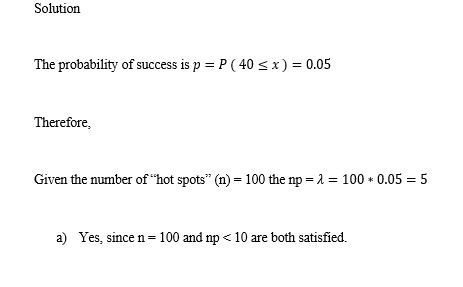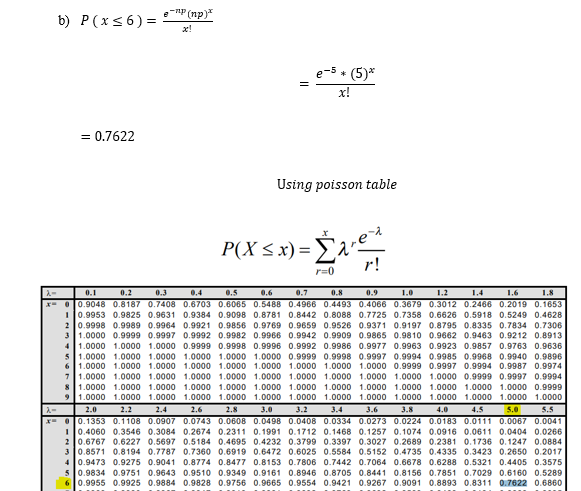What is the value of 2? (b) Use the Poisson distribution to approximate the probability that the archaeologists will find six or fewer "hot spots." Hint: Use Table 4 of Appendix II. (Round your answer to four decimal places.) (c) Use the Poisson distribution to approximate the probability that the archaeologists will find more than ten "hot spots." Hint: Use Table 4 of Appendix II. (Round your answer to four decimal places.)
What is the value of 2? (b) Use the Poisson distribution to approximate the probability that the archaeologists will find six or fewer "hot spots." Hint: Use Table 4 of Appendix II. (Round your answer to four decimal places.) (c) Use the Poisson distribution to approximate the probability that the archaeologists will find more than ten "hot spots." Hint: Use Table 4 of Appendix II. (Round your answer to four decimal places.)
MATLAB: An Introduction with Applications
6th Edition
ISBN:9781119256830
Author:Amos Gilat
Publisher:Amos Gilat
Chapter1: Starting With Matlab
Section: Chapter Questions
Problem 1P
Related questions
Question
100%

Transcribed Image Text:Magnetic surveying is one technique used by archaeologists to determine anomalies arising from variations in magnetic susceptibility. Unusual changes in magnetic
susceptibility might (or might not) indicate an important archaeological discovery. Let x be a random variable that represents a magnetic susceptibility (MS) reading for a
randomly chosen site at an archaeological research location. A random sample of 120 sites gave the readings shown in the table below.
Magnetic Susceptibility Readings,
centimeter-gram-second x 10-6 (cmg x 10-6)
Magnetic
Susceptibility
Number of
Readings
Estimated
Comment
Probability
Osx< 10
"cool"
"neutral"
"warm"
36
36/120 = 0.30
48/120 = 0.40
10 < x < 20
20 <x < 30
48
12
"very interesting"
"hot spot"
12/120 = 0.10
18/120 = 0.15
6/120 = 0.05
30 sx < 40
18
40 s x
Suppose an archaeologist is looking for geomagnetic "hot spots" in an unexplored region. We have a binomial setting where success is a "hot spot." In this case, the probability
of success is p = P(40 s x). The archaeologist takes n = 100 magnetic susceptibility readings in the new, unexplored area. Let r be a binomial random variable representing
the number of "hot spots" in the 100 readings.
(a) We want to approximate the binomial random variable r by a Poisson distribution. Is this appropriate? What requirements must be satisfied before we can do this?
Do you think these requirements are satisfied in this case? Explain.
O Yes, it is appropriate since the criteria np > 5 and ng > 5 are both satisfied.
O No, it is not appropriate since at least one of the criteria n 2 100 or np < 10 are not satisfied.
O Yes, it is appropriate since the criterian2 100 and np < 10 are are both satisfied.
O No, it is not appropriate since at least one of the criteria np > 5 and ng > 5 are not satisfied.
O Yes, it is appropriate since n z 30.
What is the value of 1?
(b) Use the Poisson distribution to approximate the probability that the archaeologists will find six or fewer "hot spots." Hint: Use Table 4 of Appendix II. (Round your
answer to four decimal places.)

Transcribed Image Text:What is the value of 1?
2 =|
(b) Use the Poisson distribution to approximate the probability that the archaeologists will find six or fewer "hot spots." Hint: Use Table 4 of Appendix II. (Round your
answer to four decimal places.)
(c) Use the Poisson distribution to approximate the probability that the archaeologists will find more than ten "hot spots." Hint: Use Table 4 of Appendix II. (Round your
answer to four decimal places.)
Expert Solution
Step 1


Step by step
Solved in 2 steps with 5 images

Knowledge Booster
Learn more about
Need a deep-dive on the concept behind this application? Look no further. Learn more about this topic, statistics and related others by exploring similar questions and additional content below.Recommended textbooks for you

MATLAB: An Introduction with Applications
Statistics
ISBN:
9781119256830
Author:
Amos Gilat
Publisher:
John Wiley & Sons Inc

Probability and Statistics for Engineering and th…
Statistics
ISBN:
9781305251809
Author:
Jay L. Devore
Publisher:
Cengage Learning

Statistics for The Behavioral Sciences (MindTap C…
Statistics
ISBN:
9781305504912
Author:
Frederick J Gravetter, Larry B. Wallnau
Publisher:
Cengage Learning

MATLAB: An Introduction with Applications
Statistics
ISBN:
9781119256830
Author:
Amos Gilat
Publisher:
John Wiley & Sons Inc

Probability and Statistics for Engineering and th…
Statistics
ISBN:
9781305251809
Author:
Jay L. Devore
Publisher:
Cengage Learning

Statistics for The Behavioral Sciences (MindTap C…
Statistics
ISBN:
9781305504912
Author:
Frederick J Gravetter, Larry B. Wallnau
Publisher:
Cengage Learning

Elementary Statistics: Picturing the World (7th E…
Statistics
ISBN:
9780134683416
Author:
Ron Larson, Betsy Farber
Publisher:
PEARSON

The Basic Practice of Statistics
Statistics
ISBN:
9781319042578
Author:
David S. Moore, William I. Notz, Michael A. Fligner
Publisher:
W. H. Freeman

Introduction to the Practice of Statistics
Statistics
ISBN:
9781319013387
Author:
David S. Moore, George P. McCabe, Bruce A. Craig
Publisher:
W. H. Freeman